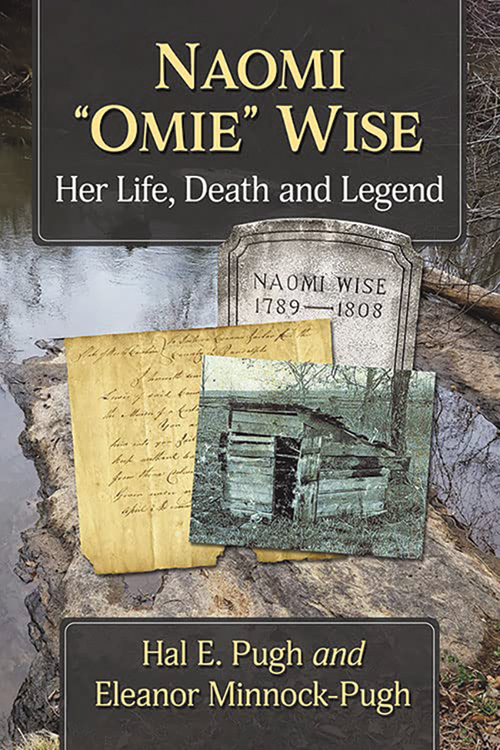
Naomi “Omie” Wise: Her Life, Death, and Legend
Reviewed by J. Brent Bill
April 1, 2023
By Hal E. Pugh and Eleanor Minnock-Pugh. McFarland & Company, 2022. 218 pages. $29.95/paperback; $17.99/eBook.
Oh, listen to my story; I’ll tell you no lies:
How John Lewis did murder poor little Omie Wise.
Most “old folkies” like me started out as young folkies cutting our teeth (and tender fingers) on traditional songs: “Hangman,” “Tom Dooley,” and “Banks of the Ohio.” All are very, very sad, usually involving the eternal triangle of lovers, and as Tom Dooley reports, someone “is bound to die.” One such song, that has been much covered by artists as varied as Doc Watson, Pentangle, Kate and Anna McGarrigle, and Bob Dylan, is not as well-known these days: “The Ballad of Omie Wise.” That song may be making a comeback though, thanks to a redemptive feminist reinterpretation by Julia Hobart on her 2019 album To Spill My Husband’s Blood.
The song tells the tale of a young maid seduced by an older man. This man has aspirations of a grand life and is also courting a woman from a family of means, who might help him achieve his aspirations. Omie Wise, however, is pregnant by him, and John Lewis must do her in, and so he does. Alas for him and for her, but it’s good for tragic songwriting and singing on dark nights in the North Carolina woods.
The song is based—as many of the old folk songs are—on a true story. This one happened in Randolph County, N.C., in 1807. Like most true stories, the truth is a bit more nuanced than the song.
Unlike the Omie of the ballad and other tales of the event that circulated, Naomi Wise was not a young maiden. She was an adult single woman who already had two children and was older than Jonathan Lewis. She fell in love with Lewis, the county constable, and became pregnant by him. Lewis, though initially infatuated with Wise, was also courting his employer’s sister, Hettie Elliott. The Elliotts were well-off, and a marriage to Hettie could improve his chances of commercial and political success in the county. If Omie’s pregnancy became public knowledge, however, such chances would be ruined. So, coming from a family who had never been shy of mayhem, he decided to kill Omie. Omie, however, had already told a number of people about their affair, and when her body was discovered against an outcropping of rocks in Deep River, suspicion immediately centered on Lewis.
Despite the ballad’s saying “No friends or relations would go on his bail,” no bail was even allowed, as the crime was considered horrendous. He was arrested and put in jail. But the Lewises had deep connections in the county. After his indictment but just before his trial, Lewis was assisted by some of those connections in an escape from jail. He made his way to Indiana Territory (Indiana not becoming a state until 1816), a treacherous trek of some 500 miles. There he along with others of his family settled in the area of Indiana across from Louisville, Ky.; went into business; married; and raised a family. His wife’s family was evidently as rough-and-tumble as Lewis’s own and were people to be feared.
Still, there were those in Randolph County who wanted Naomi’s death avenged and sought Lewis’s extradition back to North Carolina. After much effort and a dangerous journey to Indiana, that extradition occurred in 1811. In 1812, preparations for his murder trial began, and in October he was acquitted. However, he was bound over for trial on the charge of jailbreak. Finally in 1814, he was found guilty of that charge. Unable to pay the fine, he was imprisoned for a bit more than 40 days and then released. He returned to Indiana, where he died at age 34, just a few years later.
What will most interest readers of Friends Journal (and not just those of us who love music) is the Quaker thread that runs through this tale. Randolph County was well-populated by Friends. Naomi was buried in the graveyard at Providence Meeting in Pleasant Garden, N.C. Her orphaned children were indentured to or taken in by Quaker families in the area. Her grandson became a Friend. Some Friends testified in Lewis’s trial.
Hal Pugh and Eleanor Minnock-Pugh have put a good deal of research into the story and have uncovered a wealth of information and documentation about Wise, Lewis, the Quakers of Randolph County, the ballad’s origins, and nineteenth-century jurisprudence. There’s much more to the story and its various retellings than what I related above, and the writers have included much of it in their book. It’s a compelling story that is well-written. The book, in addition to being entertaining and informative, raises questions of class, station, and the roles of men and women in that time . . . and today.
J. Brent Bill is a writer and Quaker minister who lives in Indiana. His Amity: Stories from the Heartland will be released in November 2023.



Comments on Friendsjournal.org may be used in the Forum of the print magazine and may be edited for length and clarity.